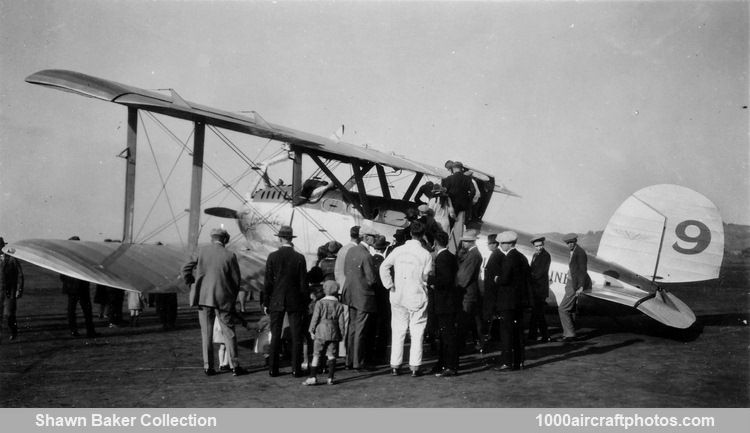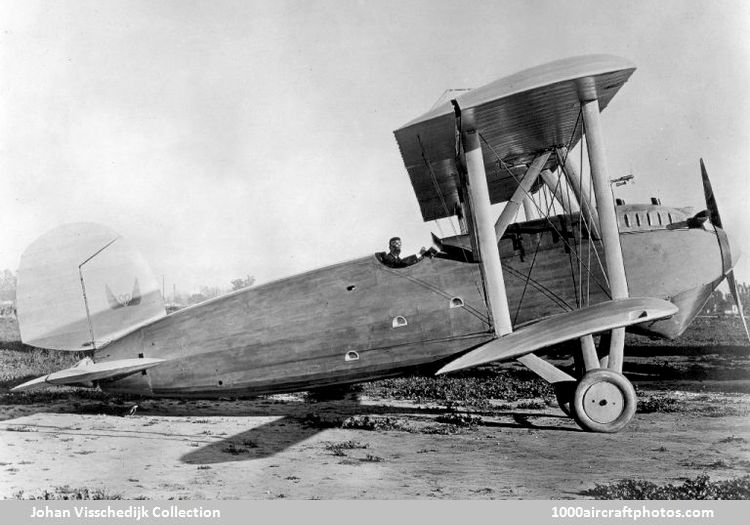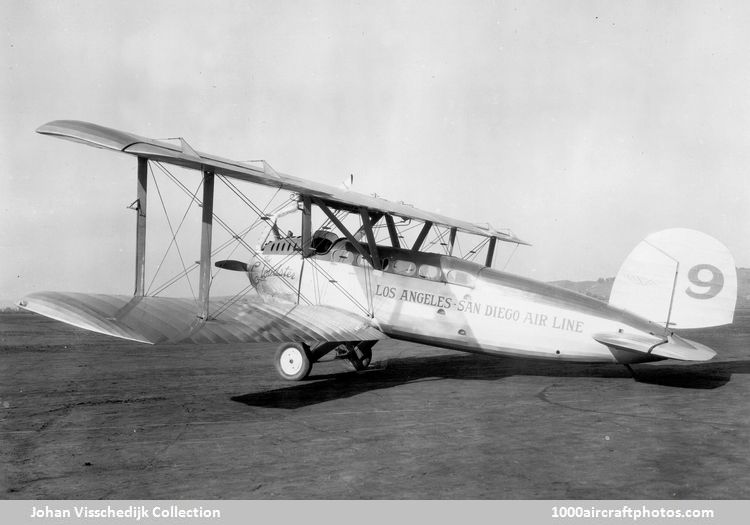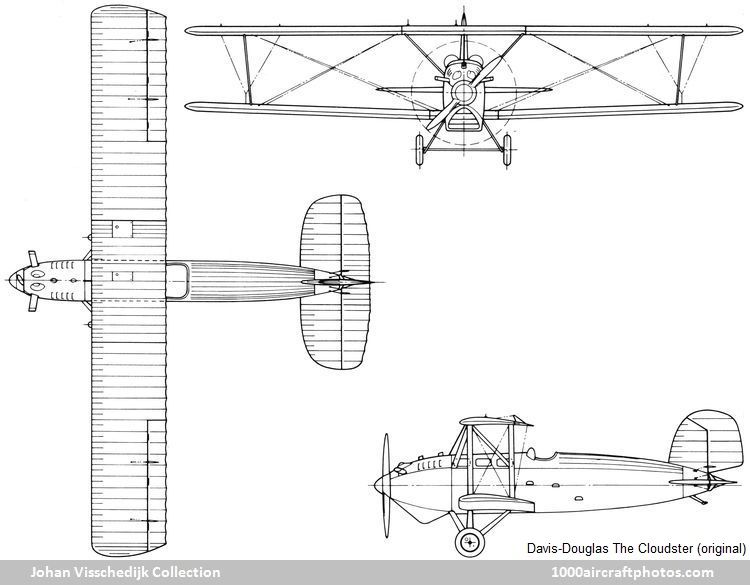12/31/2024. Remarks by
Johan Visschedijk: "After working some six years for a number of companies and services as an aeronautical engineer and designer, in early 1920 the 27 year old Donald Wills Douglas wanted to form his own company to design and construct transport aircraft. In April 1920 he found an investor, the wealthy sportsman David R. Davis, who would provide capital, on the condition Douglas would first design and construct a single aircraft for an attempt on the first nonstop coast-to-coast flight across the USA.
Davis and Douglas formed the Davis-Douglas Airplane Company at Wilshire Field, Santa Monica, California, USA on July 22, 1920. In June 1920 Douglas had rented a room in the back of a barber's shop on Pico Boulevard in downtown Los Angeles, grandiosely-named Engineering Department of the Davis-Douglas Company, and with his partner Davis had begun to design the aircraft for the none-stop flight. Soon Douglas was joined by five former colleagues from the Glenn L. Martin Company, and construction of the aircraft was undertaken in the loft of the nearby Koll Planing Mill.
The Cloudster (original) (
Johan Visschedijk Collection)
The aircraft was a single-bay tractor biplane powered by a 400 hp Liberty V-12 water-cooled engine driving a two-bladed fixed-pitch propeller. It had a fuselage of comparatively large diameter, the forward section was covered with veneer panels and housed the engine and its radiator which was faired into the lower section of the fuselage. Two fuel tanks holding a total of 660 gal (2,498 l) and a 50 gal (189 l) oil tank, with which the aircraft had a design range of 2,800 mls (4,506 km), were housed behind the engine compartment. Behind these tanks and aft of the wings there was an open cockpit with side-by-side seating for a crew of two. The rear fuselage section, tail unit and wings were of wood with fabric covering.
As airframe components were being completed in the Koll Planing Mill, they were lowered to the ground down an elevator shaft. The wings, tail unit and fuselage went separately by truck to the South Park where the aircraft was assembled in the Goodyear Blimp Hangar.
Nearing completion in February 1921, Douglas test pilot Eric Springer exclaimed the aircraft as "a real cloud duster", soon thereafter Springer attempted a first flight from South Park. However, even though the aircraft was lightly loaded, this attempt almost ended tragically as the field was quite short and Springer had to ground loop the aircraft to prevent its complete destruction. Fortunately damage was slight and on February 24, 1921, after the aircraft had been duly named The Cloudster, Eric Springer and David Davis took it on an uneventful first flight which lasted thirty minutes.
A series of test flights was then made to determine the optimum cruise performance, and during this period, on 19 March, The Cloudster broke the Pacific Coast altitude record by climbing to 19,160 ft (5,840 m). During the test flights it became clear The Cloudster was the first aircraft capable of lifting a payload greater than its own weight. Finally, in early June, Springer and Davis were satisfied that the aircraft was ready for their attempt to cross the USA from March Field, an Air Service base near Riverside, California, to Curtiss Field, Long Island, New York.
On June 27, 1921, Springer and Davis took off at 06.00 and The Cloudster headed southeast towards Yuma, Arizona, by 15.45 it flew over El Paso, Texas. Here luck ran out when the engine stopped because of a failure of the timing gear and forced Springer to make an emergency landing at Fort Bliss, Texas. Within three weeks temporary repairs had been made and the aircraft was flown back to March Field, where it was intended to fit a slightly modified Liberty engine for a new attempt.
However, as David Davis had lost his enthusiasm for the project, and the small Davis-Douglas team was focused on the company's first military order for three DT torpedo bombers, little effort was made to ready The Cloudster. Subsequently Davis left the company, later he gained fame as a the designer of the renowned Davis airfoil. Douglas found new investors and took over the company under the name Douglas Company on July 22, 1921.
In 1923, Douglas sold The Cloudster to two businessmen, T. Kinney and B. Brodsky, who intended to use it for flying passengers over Venice, California, a beach resort which they were actively promoting. For this the aircraft was extensively modified and normal accommodation for five passengers and a pilot was provided in three rows of open cockpits, with the first two cockpits replacing one of the fuselage fuel tanks. On occasion, the first two cockpits were used to each carry four passengers, thus raising the total number of people lifted by The Cloudster to ten.
The scheme, however, did not achieve much success and The Cloudster was sold in 1925 to T. Claude Ryan in San Diego. With Ryan's Los Angeles-San Diego Air Line the aircraft was used to carry passengers on the route and to fly prospective real estate buyers to San Clemente Island off the coast of Southern California. On one of these flights the upper wings and propeller of the aircraft were damaged during a landing mishap.
The Cloudster (modified) (
Johan Visschedijk Collection)
While the upper wings were being repaired by Douglas, Ryan modernized the passenger accommodation of the aircraft. The crew's two-seat open cockpit was moved forward to a position just beneath the leading edge of the upper wings, and an enclosed cabin accommodating ten passengers, five passengers on each side of a central aisle, was fitted behind the pilot's cockpit. At the same time, the Liberty engine was equipped with a large exhaust stack carrying the exhaust fumes over the wings and away from the open cockpit, while the nose was covered with sheet metal.
Later, Ryan further modified the engine installation by fitting a circular radiator around the propeller shaft and eliminating the original large propeller spinner and the radiator installation beneath the engine. After modification the aircraft was used to fly passengers between Los Angeles and San Diego on a scheduled basis. Later, following the demise of Ryan's Los Angeles-San Diego Air Line, The Cloudster was used for charter flights.
The eighteenth article of amendment to the USA Constitution of January 16, 1919, prohibited the manufacture, sale, or transport of intoxicating liquors. Towns across the borders were making a profitable business by providing a way for Americans to quench their thirst. Noteworthy amongst these towns was Tijuana, in Mexico's Baja California, which depended on a mountain road linking it to Mexicali for its supply of beer. However, shortly before Christmas 1926 this road was washed out and the bars of Tijuana were in danger of losing a substantial Christmas bonus. To overcome this problem several aircraft were chartered and The Cloudster found itself involved in this unusual airlift.
As other Mexican roads had also been washed out by heavy rains The Cloudster was diverted from the beer airlift when a wealthy Chinese businessman chartered it for a flight from Tijuana to Ensenada, further down the coast of Baja California. Arriving over Ensenada after dusk, the pilot, J.J. Harrigan, had no alternative but to attempt a landing on the beach. Unfortunately, he miscalculated his approach and hit the water before managing to stop the aircraft. The pilot and passengers walked out unhurt but, during the night, rising tide and high waves caught the stranded The Cloudster and it was totally destroyed.



